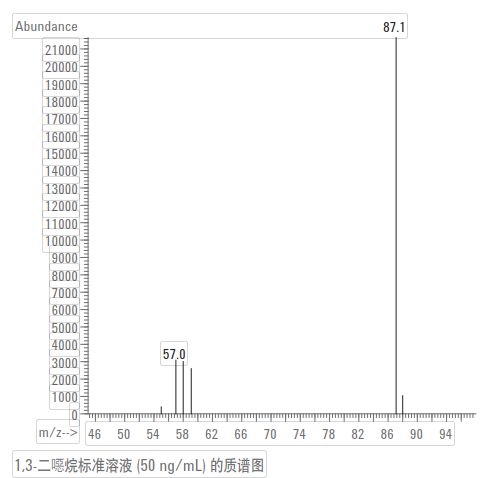Gas chromatography, gas chromatography
Application Example - Determination of 1,3-Dioxane in Cosmetics (GC/MSD Method)

Introduction
The most common uses of dioxane are as a solvent, emulsifier, and detergent, etc., and it can be absorbed into the human body through the respiratory tract, digestive tract, and mucous membranes. High concentrations of dioxane have anesthetic and irritating effects on people, and can cause eye and upper respiratory tract irritation, accompanied by dizziness, headache, drowsiness, nausea and vomiting. According to the "Hygienic Standards for Cosmetics" (2007 edition) issued by the Ministry of Health, dioxane is a prohibited substance in cosmetics.

Experimental part
Chromatographic and Mass Spectrometry Conditions
Instrumentation: Agilent 7697A Headspace Sampler - 7890A GC/
5975C Single Quadrupole GC/MSD (HS-GC/MSD) Inlet temperature: 250 °C
Split Ratio: 10:1
Carrier Gas: Nitrogen, 2 mL/min
Column: Agilent DB-5MS, 30 m × 0.25 mm, 0.25 µm Oven: Ramp from 50 °C to 150 °C at 20 °C/min Source temperature: 230 °C
Quadrupole temperature: 150 °C
Interface temperature: 280 °C
Acquisition Mode Selected Ion Monitoring (SIM)
Characteristic ions (m/z) 87.0, 58.0, 59.0
headspace conditions
Carrier gas control: Gas inlet EPC Headspace temperature: 80 °C
Sample loop temperature: 120 °C
Transfer line temperature: 140 °C
Sample loop size: 1 mL
Vial size: 20 mL
Vial equilibration time: 30 min
Vial Pressure Value: 15 psi
Vial inflation rate: 50 mL/min
Injection duration: 0.5 min
Vial Shaker Setting: 18/min
Vial pressurized gas: Helium
Experimental results





Related News
Category
Contact Us
Name:Mr Li
Mob: 18813228250
Tel: 020-84820069
E-mail: h18813228250@163.com
Address: Room 304, Building 2, Zhongheng Commercial Plaza, Qinglian Road, Xinya Street, Huadu District, Guangzhou City, Guangdong Province
 Online Service
Online Service